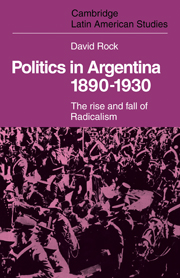Book contents
- Frontmatter
- Contents
- Preface
- 1 The components of Argentine society, 1890–1914
- 2 The oligarchy and institutional reform, 1880–1916
- 3 The rise of Radicalism, 1891–1916
- 4 The workers and their politics in Buenos Aires, 1890–1916
- 5 The first Radical government, 1916–22
- 6 The strikes, 1916–18
- 7 The Semana Trágica
- 8 1919
- 9 Postscript to the first presidency, 1920–2
- 10 The Alvear interlude, 1922–8
- 11 Yrigoyen's second presidency, 1928–30
- 12 Perspectives
- APPENDIXES
- 1 The occupational and class structure of the male population of the city of Buenos Aires by nationality, 1914
- 2 The rise of Radicalism – an historiographical note
- 3 The first Radical government and the Argentine Rural Society
- 4 The working class vote for the Radical and yrigoyenista parties in selected areas of Buenos Aires, 1912–30
- Select bibliography
- Index
- Frontmatter
- Contents
- Preface
- 1 The components of Argentine society, 1890–1914
- 2 The oligarchy and institutional reform, 1880–1916
- 3 The rise of Radicalism, 1891–1916
- 4 The workers and their politics in Buenos Aires, 1890–1916
- 5 The first Radical government, 1916–22
- 6 The strikes, 1916–18
- 7 The Semana Trágica
- 8 1919
- 9 Postscript to the first presidency, 1920–2
- 10 The Alvear interlude, 1922–8
- 11 Yrigoyen's second presidency, 1928–30
- 12 Perspectives
- APPENDIXES
- 1 The occupational and class structure of the male population of the city of Buenos Aires by nationality, 1914
- 2 The rise of Radicalism – an historiographical note
- 3 The first Radical government and the Argentine Rural Society
- 4 The working class vote for the Radical and yrigoyenista parties in selected areas of Buenos Aires, 1912–30
- Select bibliography
- Index
Summary
The central theme of this book is the political inter-relationship between different social classes in Argentina during the mature phase of the primary export economy in the forty years up to 1930. I have adopted for analysis four major groups: the landed and commercial elite of the pampas region, foreign capital, as represented mainly by British interests, the urban middle class and the urban working class, both mainly in the city of Buenos Aires. Broadly I have attempted to explore the distribution of political power between them and the mechanics of their political interactions with each other. I have also tried to show why attempts to introduce a stable institutional relationship among them eventually failed.
Secondly, the study analyses the development of the Argentine Radical Party between its foundation in 1891 and the overthrow of the third Radical government in the military coup of 1930. This is an attempt to trace the development of Argentina's first major popular movement, the specific social conditions which underlay its growth, the reasons why the movement gained prominence during this period, and what it meant in terms of the benefits and advantages to specific class and regional groups. I was greatly tempted to employ the term ‘populism’ to describe the structure and appeal of Radicalism. It would have been useful in describing the integrative, polyclasist characters of the movement, its tendency to maintain its unity by focussing attentions onto its leader, Hipólito Yrigoyen, and its use of mass mobilisation techniques of a kind which have become increasingly familiar in Latin American politics.
- Type
- Chapter
- Information
- Politics in Argentina, 1890–1930The Rise and Fall of Radicalism, pp. vii - xPublisher: Cambridge University PressPrint publication year: 1975

